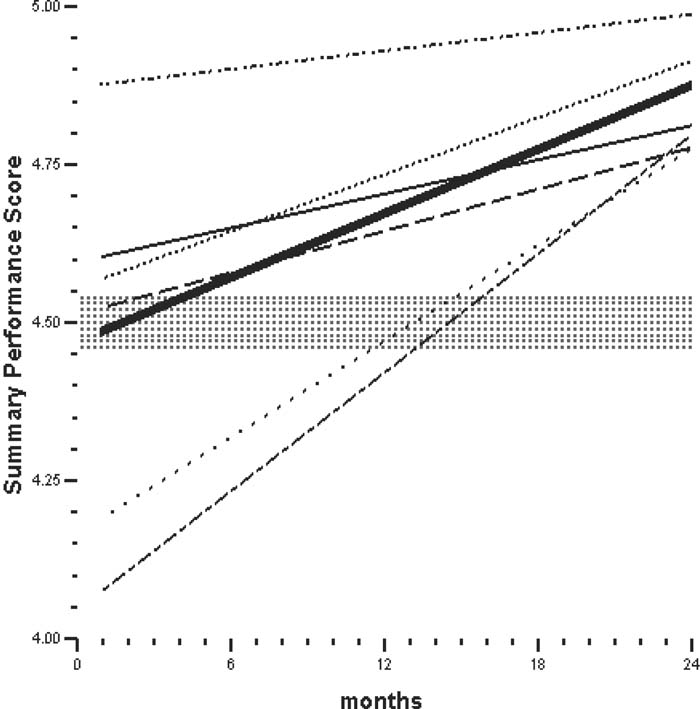Background:
Most inpatient physicians learn how to be attending physicians through experience, not formal training. Yet little has been written about how the performance of attending physicians changes over time.
Methods:
We evaluated attending physicians from our hospitalist group through anonymous validated questionnaires that were completed by residents at the end of each rotation since 2000. Mean summary scores from pooled questionnaires were compiled for each attending physician per rotation and ranged from 1 to 5 (with 5 being the best possible score). Summary scores reflected attending physicians' overall performance in teaching, clinical judgment, patient care, and professionalism. These rotation summary scores were modeled for individual attending physicians from our hospitalist group by linear regression for 2‐year periods that began with the attending physicians' first rotations. Attending physicians with less than 6 rotations of available data or those with more than 1 year of inpatient attending‐level experience prior to being hired were excluded.
Results:
During the 6 years since our hospitalist group was founded, 14 attending physicians have been hired. Of these, 8 were ineligible because of recent start dates (n = 5), brief employment (n = 1), previous experience (n = 1), or missing data (n = 1). The remaining 6 attending physicians completed a mean of 4.3 rotations per year during their first 2 years. Summary statistics (heavy line in the figure) from linear regression models fitted to each attending physician (thin lines) suggest the mean score for hospitalist attending physicians' first ward rotation (heavy line, y intercept) was 4.46 (95% CI: 4.14‐4.78), and the mean rate of growth per year (heavy line, slope) was 0.19 (95% CI: 0.06‐0.32). As an overall benchmark for comparison, the mean scores for all attending physicians from the department of medicine ranged from 4.46 to 4.54 per academic year during the 6‐year study period (horizontal dotted bar in figure). Whereas 4 of the 6 hospi‐talist attending physicians' growth curves began at or above the departmental mean and continued to diverge upward, 2 hospitalist attending physicians started with performance scores below the mean. After 12 and 14 months, however, these curves had reached the departmental mean and then exceeded it by 16 months.
Conclusions:
Most of our inpatient attending physicians' performance scores were equal to or above the department of medicine's mean score after their first rotation. Two attending physicians with low initial scores reached the departmental mean in 12 to 14 months with no remedial training. Future analyses will focus on observing other new trainees and identifying predictors of initial performance and rates of growth.
Author Disclosure:
B. P. Lucas, None; C. A. Smith, None; B. Mba, None; A. T. Evans, None; Y. Wang, None.

